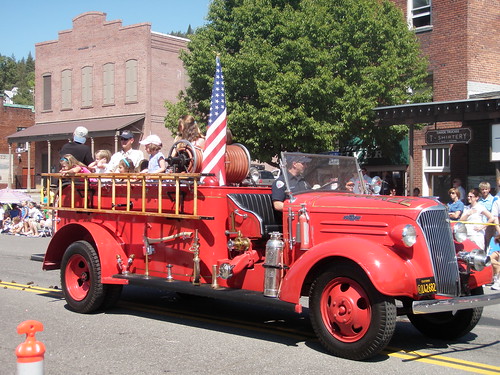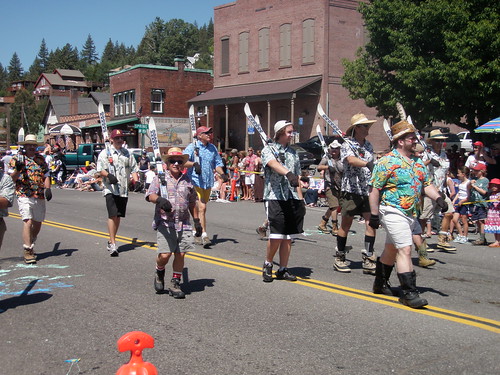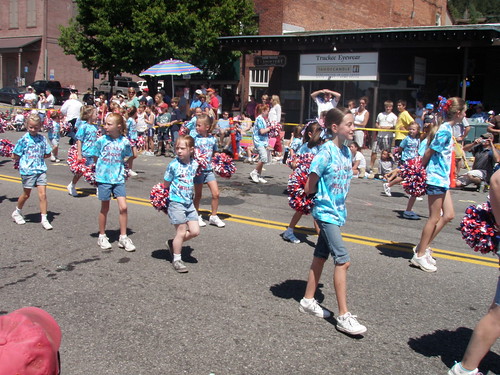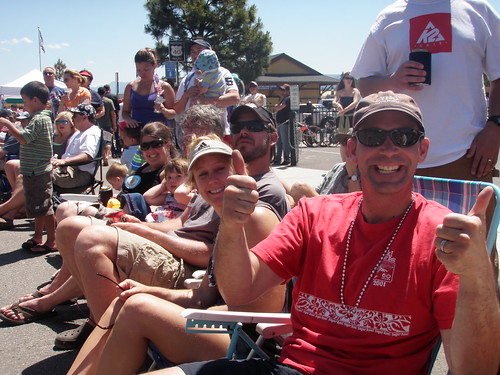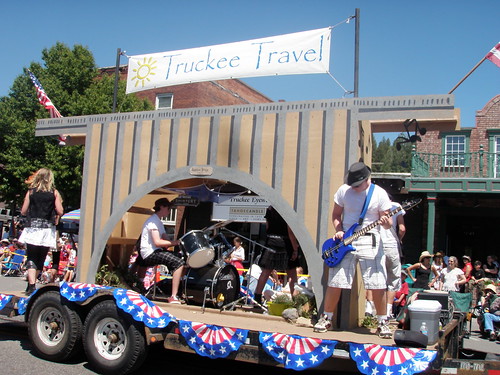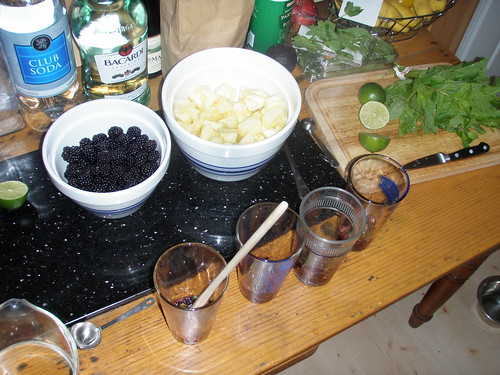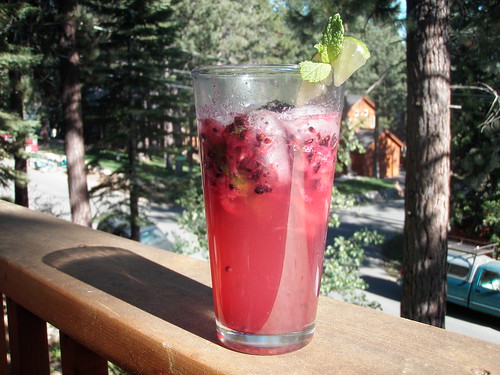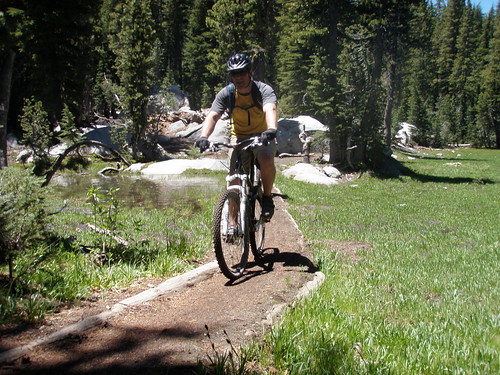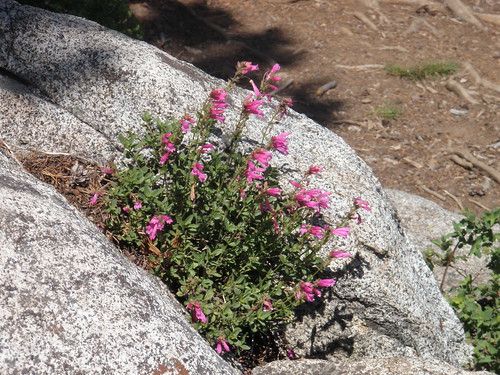First, I had a great race. Actually, “great” is a very poor word choice here. It was the kind of day where everything just falls into place, better than I could have possibly planned. It turns out to be something I do actually want to write about.
Second, when I sat down to write, I attempted to combine my “insider’s guide” with a real race report. What I came up with was a frightening conglomeration of boring information and confusing race-day details that switched back and forth between present and past tense so quickly it made me dizzy. Not fun to read.
So, instead, contrary to the promise in my last post, I’m presenting you with a race report in my standard, chronological format. I’ll give you my one-line sales pitch here: Come run Tahoe! (You won’t regret it.)
This was one of two races that I’d targeted for my season as true races. I wanted to run well. I had my sights set on a time of 10:30 for the 50M, which would be a 35 minute improvement over my time from 2007. As my spring training progressed nicely, thoughts of even faster times danced through my brain. Unfortunately, June, which should have held some of my best training, turned into somewhat of a disaster. I sprained an already weak ankle, and that, combined with an extended illness, forced way too many days off.
The week before the race I really had no idea where I stood. I had just run a 5:35 mile, but in truth, that says nothing about the kind of shape a person is in for a 50-miler. Feeling a little stressed-out, I considered blowing off my goals entirely in order to "just have fun," but I knew I couldn’t bring myself to do it. Instead of thinking a lot about my time goal during that week, I spent time visualizing my race. I thought about how I wanted to feel during each section—where I should relax and where I should push. I imagined feeling strong and solid. I didn’t think much about finishing time. I still slapped splits for a 10:30 finish onto my water bottle, but promised myself I would focus more on “feel” than on those splits.
I arrived earlier than strictly necessary on race morning, but I enjoyed seeing the 100 mile runners off. It was only for those brief few moments of excitement that I envied them their journey. The rest of the day, I was only too glad to be running half as far!
 50M and 50K runners gather at the start
50M and 50K runners gather at the start
I enjoyed socializing with friends, and had plenty of time to tape my feet and slather on some sunscreen before heading down the hill for the start. Dave gave his standard pre-race briefing, and made us all promise that we would only run the Red House Loop one time. Apparently every year, at least one person makes the mistake of running it twice. Trust me; you do NOT want to be that person!

"How many times are you going to run the Red House Loop?" ("Just once!")
I stood a few paces back from the front with Catherine, who is training for the Leadville 100. I wasn’t really worried about where I started because the first mile is on dirt road, which gives everyone plenty of time to sort themselves into appropriately paced groups.
The single-track to
The wildflowers were lush along the shores of Marlette, and the light of the rising sun on the surrounding peaks was mirrored in its still waters. I used my “take lots of pictures” strategy to keep my energy in check and my mindset mellow. Fortunately, there was never a lack of subjects for my photos.

The climb up from the lake to

Looking back down the hill, while hiking towards Hobart.

"Time for some clogging!" The Irish Pub at Hobart. (Photo courtesy of Nico Vera)


The 5 miles between Hobart and the Tunnel Creek aid station take you over Marlette peak. It begins with a beautiful and not-too-technical, single-track climb. (This is a blast to run on the return trip!) I reached the top after only a mile or so, and knew that there would be quite a bit of downhill for the next 3-4 miles. Runnable downhill isn’t in great supply for me on this trail, so part of my strategy was to make sure I made use of it whenever I could. Even though it was still early in the race, I ran strong through this downhill section.
 Flowers line the trail everywhere!
Flowers line the trail everywhere!Unfortunately, it was also somewhere in here that I tweaked my bad ankle. Luckily, no one was around when I emitted a string of curses and my world came crashing down. Had I just ruined my entire race? I was pretty sure it hadn’t been a race-ending tweak, but I ran on full of anger, frustration and fear. I decided the best course of action was to pop four Advil and ignore it, so I did.
Last year I fell in love with the Tunnel Creek aid station. They have music, party décor, and at least 3 different tents. There is a
While someone filled my bottles and put ice in my bandanna, I stuffed potatoes and watermelon in my mouth.
A volunteer gave directions to another runner: “You run the Red House Loop next.”
“The Red House
I find it’s often best to meet grim prospects with enthusiasm.
The volunteer briefly gave me a wide-eyed, questioning stare, then his face cracked into a grin. “Now that’s what we like to hear!” Down, down down the Red House Loop.
Down, down down the Red House Loop.
The Red House Loop is a 6 mile “lollipop” between miles 11 and 17. I headed off down the steep, sandy hill towards the lowest point on the course. Many of the 100 mile runners were coming toward me, having started an hour earlier. I cheered them enthusiastically as I negotiated the hill, trying my best to be careful without fighting gravity too much. I recognized and cheered Peter Fain running towards me, on his way to, yet again, winning the 50K. Good God, I thought, is there any hill too steep for that man to run up?
After filling up at the aid station, about halfway through the loop, I set off to negotiate the return trip. It begins with a stretch of uphill known as the Red House Flume. Because was a flume, it’s an extremely moderate hill, and I was able to run it at a steady pace.
I chatted a bit with some men behind me wearing Team Diablo shirts. Eventually one of them said, “Hey, just flick your elbow if you’re getting tired.”
“Huh?” came my brilliant response.
“You know,” he explained, “if you need someone else to take the lead. You’re pulling the peleton here!”
I glanced back, and sure enough, there was a string of men down the trail, running behind me. Obviously it’s not the same thing as in bike racing, but still, sometimes setting the pace holds a certain amount of pressure. In this case though, I loved being the engine on the train of men up the hill.
“I’m great; I think this is fun!” I replied, and up the hill we went. Running up the flume. (It doesn't even look uphill, does it? See, the Red House Loop isn't all bad!)
Running up the flume. (It doesn't even look uphill, does it? See, the Red House Loop isn't all bad!)On my second visit to Tunnel Creek, Michelline tried to tease me about not running the 100 this year. I enthusiastically called myself a wimp for only running the 50M, and I had no regrets about it! I’m glad she expects more of me though.
 The Tunnel Creek Aid Station.
The Tunnel Creek Aid Station.At this point, the 50M course diverges from the 50K. I set off on the 9 mile out-and-back (for a total of 18 miles) to
As I sang along in my head, I passed Carol Rewick, who had soundly beaten me two years ago at the Helen Klein 50M. We exchanged hellos, and she said she’d try to stay with me, so I encouraged her to do so. It wasn’t long though before she disappeared somewhere behind me.
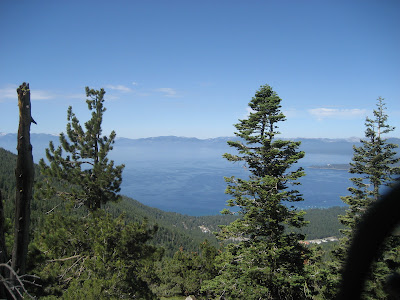

Eventually I began to see the 100 mile leaders heading back towards Tunnel Creek. This is one of the things I enjoy about this section—we get to see so many of the other runners out on the trail. I recognized eventual winner Erik Skaden, who was in about 4th at that point, and Sean Lang, running strong.

I could tell I was within about a mile of the aid station when the trail became forested, flattened out and widened. It was fortunately at about this time that I apparently decided to stop paying attention to what I was doing, trip over absolutely nothing, and go flying through the air. I say “fortunately” because there are many, much worse places that I could have landed. Like, say, with my head against a rock for instance. Instead, I went skidding along the trail gathering a collection of road rash and dirt along the left side of my body. Not pretty, but ultimately not that bad. It was also at this time that I gave profuse thanks for my hand-held bottles. My hands would have been shredded if not for their protection. I did wonder about my camera though, which, residing in the pocket of one bottle, certainly took the brunt of the crash.

I rinsed off at a creek, more concerned about the fact that I was completely filthy than the blood oozing down my leg. It was shortly after this that I saw the first woman in the 50 mile race. I didn’t recognize her, but I guessed I was still 10 minutes out from the aid station, giving her probably a 25 minute lead over me. I decided catching her wasn’t worth worrying about too much at this point, (halfway) but I was curious how many more women I would see before reaching the turnaround.
My visit to the
 The circus at Mt. Rose
The circus at Mt. Rose
As I dashed back in, I heard the volunteer checking in runners say to her helper, “Didn’t she already come through?”
“Forgot something!” I yelled over my shoulder, feeling like a prize idiot, as every spectator watched in confusion.
I grabbed my bandanna full of ice and a couple of PBJ’s off the table, and scurried back out.
“I’m leaving for good this time, I promise!” I told the volunteer.
Well, that was a complete disaster, but I felt better once I got back on the trail. It wasn’t long before I saw Turi, heading the other way, and he told me I was in fourth place. I figured I must have miscounted, but I wasn’t overly concerned. Across the meadow. (Photo courtesy of Turi Becker)
Across the meadow. (Photo courtesy of Turi Becker)
I was just past the halfway point of the race, and it was here that I had planned to pick things up a bit. I knew the next 9 miles were rolling, but with plenty of runnable downhill. The 8.5 miles from Tunnel Creek to  The trail heading back towards Tunnel Creek
The trail heading back towards Tunnel Creek
I saw a number of friends heading the other way, including Catherine and Nico. It wasn’t long before I came up behind Kelly Rigdway. She must have been the 3rd woman I hadn’t seen. I met her at last year’s Auburn Trails 50K, where she kicked my butt. I love Mark Tanaka’s photo caption of her from his report on last year’s TRT: “Kelly Ridgway—50 is the new 30.” She’s pretty badass.


I enjoyed moving well along the trail, which offers stunning views on both sides of the ridge. I decided to check the damage to my camera, and found it shockingly unscathed. (The screen had already been broken by my husband on a climbing trip, so I didn’t have to take the blame for that one!)

By the time I reached Tunnel Creek for the last time, the splits had washed off my bottle completely. It didn’t matter, because I knew I was well ahead of 10:30 pace. Some quick math told me I might even make ten hours.
I couldn’t believe this was already my last visit to Tunnel Creek. I wished Michelline a sad farewell, thinking how short these 50 milers are, and headed towards 

Cresting Marlette is one of my favorite stretches of trail. You look down upon both
I started the hike up
Now, after 8 hours of running, I finally had to pee. How inconvenient. I seriously didn’t have time for this, and I wasn’t totally sure that Pink-Shirt-Girl (who's name turned out to be Maria) wasn’t going to catch me. After I finally relieved myself and felt much better, I realized the 20 second detour probably wasn’t going to kill my chances at a sub-ten finish. I recanted all my bitter thoughts toward men, who don’t actually have to stop running when they need to pee.  Emerging from the trees, heading toward Snow Valley Peak
Emerging from the trees, heading toward Snow Valley Peak
I’d been pushing my pace for long enough that my stomach was finally starting to rebel. I’ll tell you something here: I hate throwing up. I just don’t do it. Not an option. I don’t mind other people’s puke, and I’ll even hold your hair back for you while you do it, but I can’t handle the act myself. Throwing up makes me feel like a 5-year-old who wants her mommy, and women who plan to run sub-ten do not cry for their mommies! I take one of two courses of action when feeling nauseated: I slow down, or I stop eating. Hell if I was going to slow down, but with 10 miles to go it was too early to give up on eating. I kept the e-caps going, and used my weak mix of Amino Vital from the aid station to wash down a Clif Block. These are usually the only things that go down when my stomach is upset, and I was glad I had some.



As I approached the
 Snow Valley Peak aid station. See those flags? They're not being held out by anything. That's the wind.
Snow Valley Peak aid station. See those flags? They're not being held out by anything. That's the wind.I’d told myself I needed to leave the summit with no more than 8:45 on the clock in order to have a shot at getting in under ten. When I checked my watch as I started the descent, it read 8:40. I knew there was work to be done if I wanted this, and I pulled myself together and focused on running.
The first mile downhill is technical, and I was cautious. I knew I was tired, and a spill could mean disaster. Runners are also graced with some very distracting views off to the right, and I did my best to appreciate them while safely making haste.
Once the trail goes back below tree line, the running becomes much easier. If you’re a good downhiller, you can really fly here. Me? Well, I did my best. I practiced what I had been practicing all spring and summer: using my core to stabilize myself while running downhill.
Eventually I realized that I had been focusing so hard on running fast without falling, that I didn’t notice my stomach issues so much. I was now passing the back of the 50K pack, and the runners graciously stepped aside every time they heard me coming. I didn’t even have to ask anyone to pass.
As the minutes ticked by and I still hadn’t reached the Spooner aid station, which would tell me I had only 1.5 miles to go, I began to lose hope. Maybe I was doomed to run 10:05. As much as I wanted to be okay with this, (it was, after all, an hour improvement on my best time for the course) I knew I wouldn’t be.
When the aid station came into sight, I checked my watch. 9:45. I needed to run at least 10 minute pace, and I knew it wouldn’t be as easy as it sounded. I flew through the aid station without stopping, and prepared to suffer through the last mile and a half as fast as I could.
I ran down the trail towards
It wasn’t until I was yards from the finish line that I finally realized I was going to make it. Time on the clock read 9:57. I’ll take that, I thought, and smiled as I crashed into a chair in the finish corral. I was the 2nd woman (ten minutes behind first place) and 6th overall.
Two cokes, the best shower ever, and a commemorative TRT beer later, and I was sitting at the finish line with a group of other runners, watching folks finish, and cheering the 100 milers who were only halfway. I was hoping to see several friends cross the line, but somehow I missed all of them. Still, I managed to find the camaraderie that I love in this community with the runners that I met that day, as we sat around swapping stories from these and other races. I was giddy with the day’s adventures, and I allowed myself the luxury of not rushing home, but just relaxing and soaking it all up.
I have a lot of thoughts about what went right for me that day. Some of it was training, but I also had a lot of problems in that department. In the end, I think it was mostly course experience. I was able to visualize every step of the trail, and know very clearly how I should feel at different points. When race day arrived, I simply did what I’d been practicing.
Thanks, as always, to Dave and his incredible staff for all the work it takes to put on this event. I really appreciate all the little touches. You guys are amazing!
As you can probably imagine, this year’s race only further cemented my affections for this event. Sylas, my favorite Sierra Sun sports editor, asked me today what distance I plan to run next year. The truth is, I don’t know. I do, however, know that I’ll be back.






